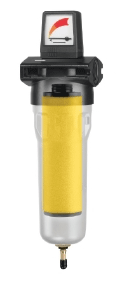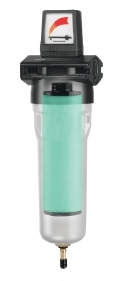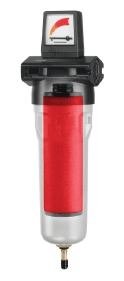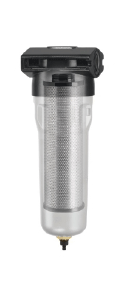Why use compressed air filters?
Filtration is key in any compressed air system; properly maintained compressed air filters can improve the lifespan of your air tools and avoid contamination of the system. Compressed air filters are fitted into your pipework system usually before and after the dryer, with the aim of both protecting your dryer and downstream equipment and plant. The filters are designed to remove contaminants (usually oil) that unavoidably enter the compressed air from the compressor and also to remove contaminants that are sucked into the air compressor from the environment (usually dust / grit / microbes etc). The compressed air filter is made up of two parts, a tough housing capable of withstanding the pressure and temperature of the compressed air directly from the compressor and a replaceable filter element. Typically the filter element needs replacing annually.
When buying inline filters for your compressed air system specify the filter based on capacity of the air compressor (always size the filter higher than the air compressor capacity) and then select the type of filter required (see below). We recommend fitting a dust filter (S range) before the dryer and then a high efficiency filter (D range) after the dryer.
You can buy either the complete filters (including housings) or just the replaceable elements from our online shop
Specialist compressed air filters
Multi-stage filtration is essential for breathing-air or food-grade applications where air quality is of utmost importance. Compressed air filtration is usually carried out in stages, as such our range of filters are available in 5 different grades:
All of these are available to order online from our dedicated online shop

Pre Filter (P Range) This is the first stage that should be considered. It is suitable for intercepting a large quantity of solid and liquid particles up to 3 micron in diameter, with minimal drop in pressure. The filter element is made of layers of glass microfibre and layers of non-woven polyester. This is a low cost way to instantly improve air quality and protect your compressor. The water and dirt is drained from the bottom of the filter.

Dust Filter (S Range) This compressed air filter has the same features as the pre filter, however the element on a dust filter removes solid and liquid particles down to 1 micron. This filter can be used as additional filtration to the pre filter or alternatively it can be used after a pre filter itself to avoid premature clogging of a coalescence filter further down the line. The filter element is made of layers of glass microfiber and layers of non-woven polyester.

Coalesence Filter (C Range) This interception compressed air filter will remove hard and oil particles up to 0.1 micron in diameter. This filter, by means of impact, interception and coalescing principles, causes the submicronic liquid particles, which strain through the element from the inside, to collide with each other, forming microdroplets which will drip at the bottom of the filter housing. The element itself is made of a layer of borosilicate fibre-layer supported by two inner and outer stainless steel structures.

High Efficiency Coalesence Filter (D Range) This is a higher-efficiency version of the coalescing filter which will remove hard and oil particles up to 0.01 micron in diameter. Air passing through this filter is practically 99.99% oil free; therefore it is suitable for use in installations where purity of air is a must. It can be utilised after a dryer as a de-soiling filter and is the perfect pre filter for the activated carbon series.

Activated Carbon Filter (V Range) There are many applications which require air to be free of micro impurities as well as odours and vapours. This activated carbon filter, through the absorption process, is able to attract the odours and vapours left after de-soiling, and attach them to the active carbon particles. The activated carbon filter must always be preceded by a dryer to remove moisture and coalescence filter, ideally a high-efficiency model, to remove contaminates. The filtering element is made of a bed of activated carbon covered by a fibre coating, kept in place by an inside and outside stainless steel wall.

If you have any queries about our range of filters or would like some advice about choosing the right filtration for your application please don’t hesitate to contact us.

We also stock a wide range of genuine Domnick Hunter filters and replacement elements can be purchased direct from our dedicated e-shop.



